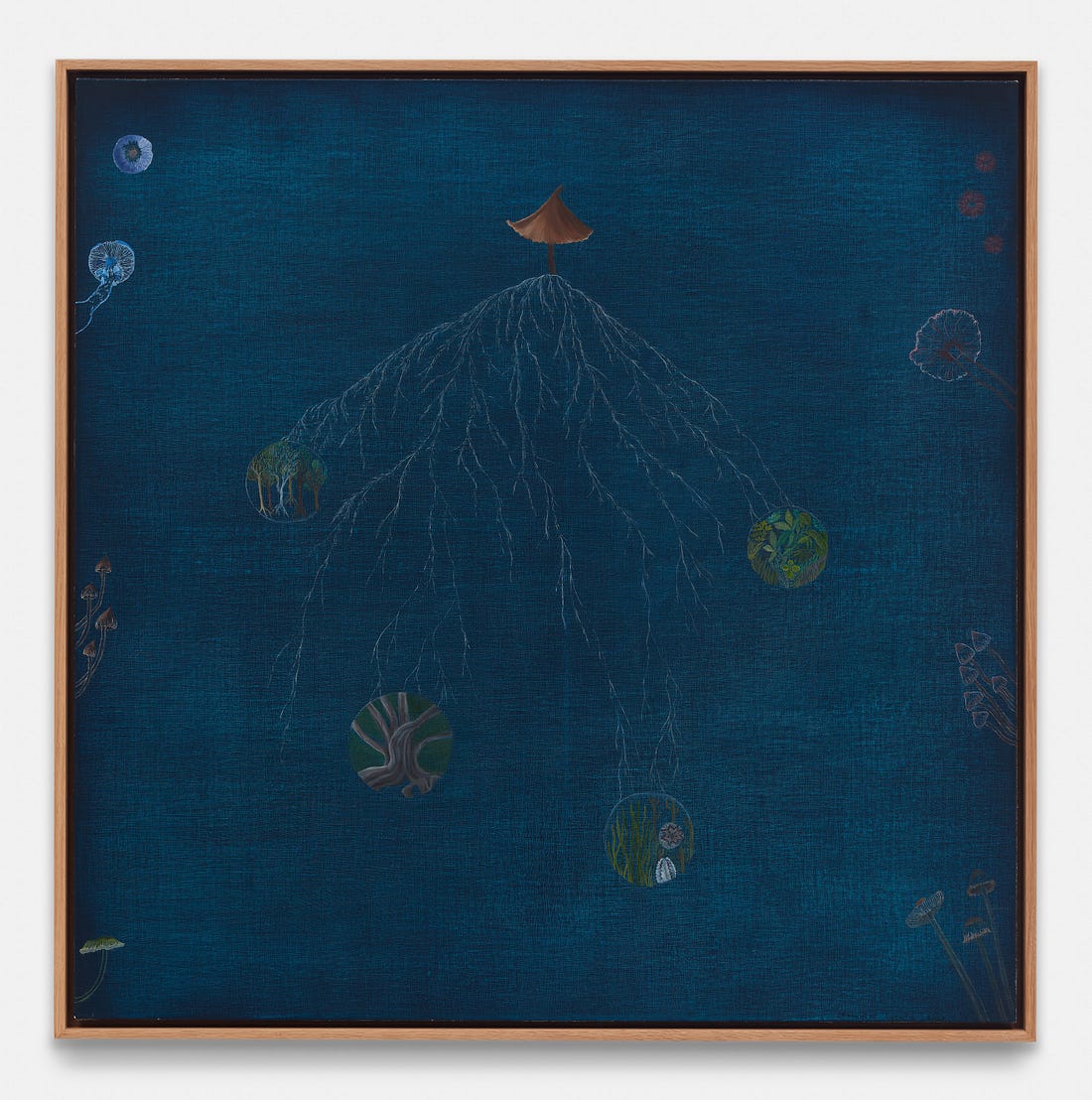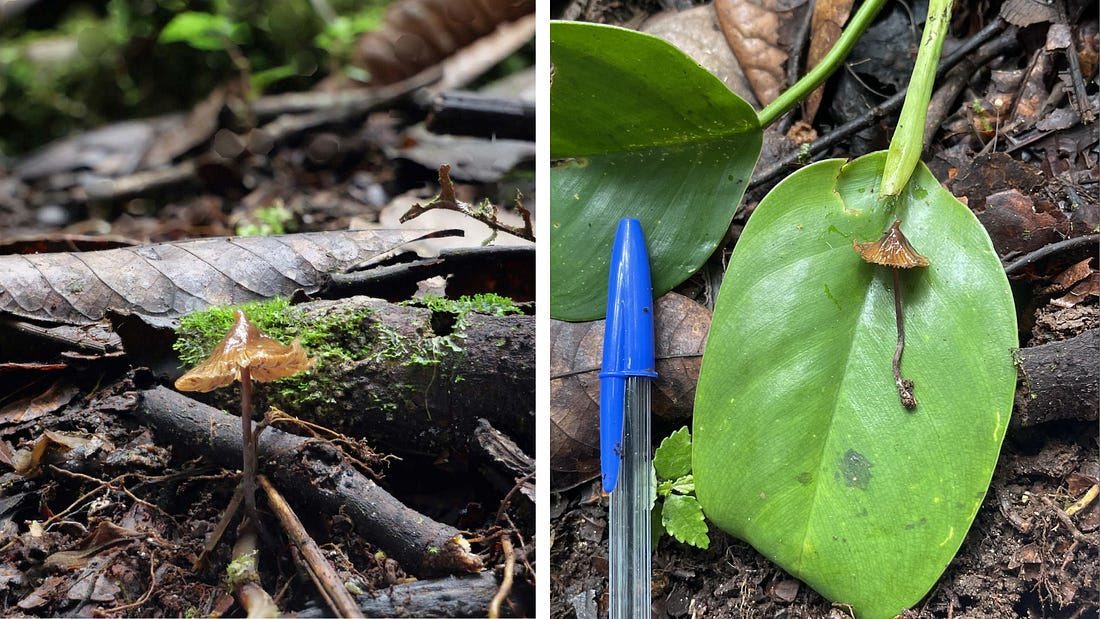|
Art, conservation, and psychedelics
A recently discovered species of psychedelic mushroom from Ecuador has inspired a painting, a song, and a potential environmental win.
When people hear that I’m an enthusiastic member of the New York Mycological Society, they often ask how I got into mushrooms. The answer, for me, is primarily ecological — in the course of reporting on agriculture, I got increasingly interested in soil health, and from there found myself fascinated with mycorrhizal fungi and the role they play in all kinds of ecosystems, from cotton fields to forests.
But many other people join the “mushroom club” for other reasons — perhaps they like cooking or foraging wild foods, are artists inspired by the fantastic forms that fungi take, want to participate in community science, or like using psychedelics. Most of the mushroom spaces I find myself in contain some combination of the above, and yet discourse and public writing often silo these different pathways that lead people into an interest in fungi.
The recent discovery of a new species of psychedelic mushroom in the cloud forest of Los Cedros, Ecuador, offers a ripe starting point for bringing some of those conversations together. The tiny fungus, called Psilocybe stametsii, was named after Paul Stamets, the North American mycologist and mushroom entrepreneur who has inspired a generation of mycology and psychedelics enthusiasts. It was found on a research trip that included musician Cosmo Sheldrake (brother to Merlin Sheldrake, author of the best-selling fungi book Entangled Life); writer Robert MacFarlane (who recounts the journey in his latest book Is a River Alive?); and Chilean-Italian mycologist Giuliana Furci, among others.
Their trip focused on the growing “Rights of Nature” movement, which advocates for the recognition of ecosystems and “more-than-human” species as having inherent legal rights. The trip and discovery inspired new art from Chilean-born artist and poet Cecilia Vicuña, whose latest exhibition Arch Future in Brussels features a painting and sound installation inspired by the discovery.
I wrote about Vicuña’s art, and the story of the mushroom and discovery that inspired it, for The Microdose. For more on grief, “hearing” from mushrooms, using music to protect a forest, and the intersection of conservation, art, and psychedelics, read the full story here.
An aside: As with most stories, there were parts of this one that got cut, but have stuck with me nonetheless. In this case, it was a quote from Cosmo Sheldrake, who has made compositions with sounds pulled from everything from whale calls to the fungal underground. As we were discussing the Rights of Nature movement, he said:
“We very readily and easily accept that ships and corporations can be subjects of rights, but we have a much harder time thinking that a vastly complex social animal with ridiculously sophisticated language, millions of years older than our own, might also be considered the subject of rights.”
A fair point – why does ExxonMobil have more legal rights than, say, a whale?
Speaking of whales, here are a few of the latest stories I edited for Atmos: Omnia Saed on the science and poetry of whale falls, Amelia Urry on fractals and the natural world’s unpredictability, Marcia Bjornerud on what we can learn from rocks, and Ferris Jabr on why the Earth is not a superorganism.
Lastly, Ash Sanders in a heart-rending-and-healing piece on the undrowning of a river, in one of my favorite stories I’ve had the pleasure of editing this year. (If you’re new to Ash’s work, this story on climate anxiety is another all-time favorite from her oeuvre.)
One final thing: Today, after four years (!) of working full-time as a freelance journalist covering the climate crisis and environmental justice, I’m finally turning on paid subscriptions for this newsletter. Over the years, a few of you have expressed a desire to more concretely support my work. Perhaps you understand that journalism jobs have been decimated over the last ten years and wages for freelancers have stagnated (or even declined);¹ perhaps you want to make sure the kind of work that I do keeps happening; perhaps you’re just kind. Whatever the reason, your belief in my reporting means the world. This is me finally giving you the opportunity to support it concretely.
You will still be able to read for free if you want or need to; this is not a “pay if you want to read this newsletter” subscription; it’s a “pay if you want to support my work” subscription. Regardless of whether your situation allows you to be a paying subscriber or not, I’m so glad that you care about the planet and the communities of people (and fungi and trees and whales) I report on, and I’m honored to have you as a reader. And for those of you who find that the modest subscription price wouldn’t be a burden and you’re willing to chip in, thank you so much for investing in a world where this kind of journalism focused on climate solutions and environmental justice can continue to exist.

